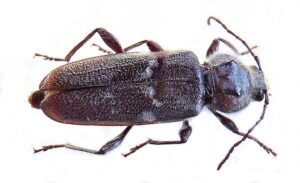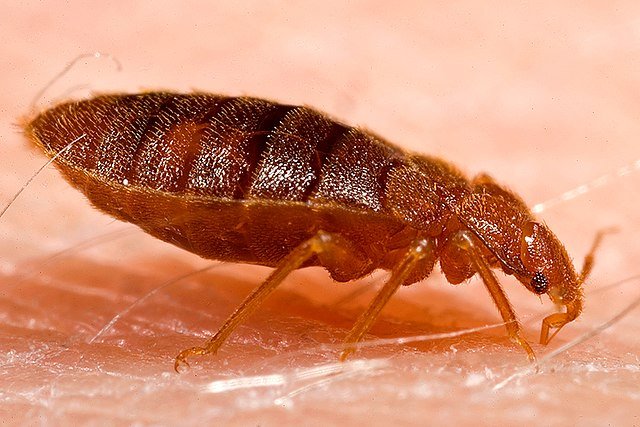Old House Borer (Hylotrupes bajulus): Identification, Damage & Control
 The Old House Borer (Hylotrupes bajulus) is one of the most serious wood-boring beetles found in homes and buildings. Unlike pests such as the Carpet Beetle (Anthrenus spp.) that damage fabrics or the Cigarette Beetle (Lasioderma serricorne) that infests stored products, the old house borer is a structural threat. Its larvae bore deep into seasoned softwoods, especially pine, leaving tunnels that weaken beams, flooring, and furniture.
The Old House Borer (Hylotrupes bajulus) is one of the most serious wood-boring beetles found in homes and buildings. Unlike pests such as the Carpet Beetle (Anthrenus spp.) that damage fabrics or the Cigarette Beetle (Lasioderma serricorne) that infests stored products, the old house borer is a structural threat. Its larvae bore deep into seasoned softwoods, especially pine, leaving tunnels that weaken beams, flooring, and furniture.
Despite its name, infestations are not limited to old houses. New constructions can also be attacked if they use susceptible timber. In Europe, North America, Africa, and Asia, this insect is considered a major pest of structural timber.
This guide explains how to identify, prevent, and control old house borers, highlighting their biology, damage, and management strategies.
Identification
Adults:
Size: 8–25 mm long.
Color: Dark brown to black, often with two faint grayish lines running lengthwise.
Antennae: Moderately long, not exceeding half the body length.
Distinctive: Flattened body, slightly tapered at the ends.
Larvae:
Creamy white, elongate, up to 30 mm long.
Strong mandibles designed for chewing wood.
Responsible for structural damage.
Exit Holes:
Oval-shaped, around 6–10 mm wide, larger than the round holes of Powderpost Beetles.
Often with coarse wood dust (frass) nearby.
Frass:
Grainy, not powdery like in powderpost beetle infestations.
Biology and Lifecycle
Eggs: Females lay eggs in cracks and crevices of wood, particularly in unfinished timber.
Larval Stage:
Can last from 2 to 10 years depending on conditions.
Larvae tunnel extensively through the sapwood of softwoods.
Pupation: Takes place inside the wood, close to the surface.
Adults: Live only a short time (2–3 weeks), emerging to mate and lay eggs.
The long larval stage is why infestations can persist for years without detection.
Ecology and Distribution
Found across Europe, North America, Asia, and parts of Africa.
Prefers softwoods like pine, spruce, and fir.
Often associated with structural timber in roofs, beams, joists, and wooden paneling.
Rarely attacks hardwoods.
Can infest both new and old buildings if timber is untreated and has sufficient moisture.
Damage and Risks
Structural Weakening: Larvae carve out large galleries, reducing the strength of beams and joists.
Aesthetic Damage: Exit holes and frass spoil the appearance of wooden surfaces.
Economic Impact: Infestations in Europe and the U.S. account for millions in restoration and repair costs annually.
Comparison with Termites: Unlike Termites, which consume wood continuously, old house borer larvae cause irregular tunneling with coarse frass deposits.
For museums, heritage homes, and historic buildings, infestations can threaten irreplaceable wooden structures.
Signs of Infestation
Large, oval exit holes on timber surfaces.
Coarse, gritty frass spilling from holes.
Tapping or clicking sounds made by larvae inside wood.
Weakened timber that breaks under pressure.
Presence of adult beetles indoors, especially near windows.
Household Control Strategies
Prevention
Use kiln-dried, treated wood during construction.
Apply varnish, paint, or sealants to exposed surfaces.
Avoid bringing infested firewood indoors.
Moisture Management
Keep wood moisture levels below 13%.
Ensure good ventilation in attics and crawl spaces.
DIY Options
Replacing infested wood when damage is localized.
Applying borate-based preservatives to unfinished timber.
Freezing small wooden items to kill larvae.
Professional and Long-Term Control
Inspection: Professionals identify whether larvae are still active (fresh frass, sounds).
Localized Treatment: Insecticidal injections or surface applications to kill larvae in specific beams.
Fumigation: For large-scale infestations in heritage or commercial buildings.
Heat Treatment: Raising wood temperature to lethal levels for larvae (above 50 °C).
Integrated Pest Management (IPM): Ongoing monitoring and preventive treatments to protect high-value structures.
Comparisons with Similar Pests
Powderpost Beetles: Smaller exit holes, fine powder frass, infest hardwoods.
Termites: Create mud tubes, destroy wood continuously, no exit holes.
Drugstore Beetles (Stegobium paniceum): Stored product pest, not wood-damaging.
Silverfish (Lepisma saccharinum): Attack books, paper, and fabrics, not wood.
Case-Bearing Clothes Moth (Tinea pellionella): Wool and textile damage, never timber.
Final Thoughts
The Old House Borer (Hylotrupes bajulus) is a pest that every homeowner, architect, and conservator should take seriously. Unlike nuisance insects such as Silverfish or Case-Bearing Clothes Moths, this beetle’s larvae threaten the very structure of buildings. With a larval stage that can last up to a decade, infestations often remain hidden until damage becomes extensive and costly.
The most effective defense is prevention—using kiln-dried and treated timber, sealing surfaces, and controlling moisture. Once infestations take hold, professional intervention is usually the only reliable option, ranging from localized insecticidal treatments to fumigation or heat treatment for larger structures.
Old house borers remind us that pests are not always obvious. Their quiet tunneling can turn sturdy beams into fragile shells, leaving both modern homes and historic treasures at risk.
FAQs About Old House Borers
Q: Why are they called “old house borers”?
A: The name comes from their frequent presence in older wooden structures, though they can also infest newer buildings if untreated softwood is used.
Q: How do I know if my wood is still infested?
A: Fresh frass near exit holes, clicking sounds inside wood, and newly emerging adult beetles are signs of active infestations.
Q: Can I treat an infestation myself?
A: Small furniture pieces may be treated with freezing or borate solutions, but structural infestations require professional help.
Q: Do they attack hardwoods?
A: Rarely. Old house borers prefer softwoods such as pine, spruce, and fir.
Q: How long do larvae stay inside the wood?
A: Depending on temperature and moisture, larvae may remain hidden for 2–10 years before emerging.
Disclaimer
This article is for informational purposes only. Pest control laws and approved chemicals vary by country. For best results and legal safety, we strongly recommend contacting a licensed pest control professional in your local area. Always make sure that the pest control technician is properly certified or licensed, depending on your country’s regulations. It’s important to confirm that they only use approved products and apply them exactly as instructed on the product label. In most places in Europe, UK, or USA, following label directions is not just best practice—it’s the law.
Author
Nasos Iliopoulos
MSc Agronomist & Certified Pest Control Expert
Scientific Director, Advance Services (Athens, Greece)
Licensed Pest Control Business – Ministry of Rural Development & Food (GR)
References
Penn State Extension – Old house borer
Wikipedia – Hylotrupes

